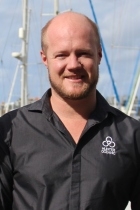The Engineering Watchkeeper

The exact role of the engineering watchkeeper varies from vessel to vessel. A vessel's size, number of crew and weather are important factors, as are the expectations of the Chief Engineer or Captain.
Some vessels approve a simple hourly check while the engineer is awake and every 2-3 hours outside ‘normal’ hours. Larger vessels with multiple engineers may be expected to carry out a rotation covering a 24 hour period.
It can therefore be hard to define a standard operating procedure (SOP) for a watch keeping engineer, but there are a number of fundamentals that remain consistent to ensure safe passage and the well-being of crew members.
A typical scenario onboard smaller yacht programs is a general rotation between the Captain, Engineer and Mate with a check every hour during a 24 hour period. Generally speaking, a log may be used to record operating temperatures, tank levels, equipment settings and general observations.
On larger yacht programs, watchkeeper guidelines need to be followed and logs taken periodically. Strict rules apply around the duration of a watch period as well as making the watch duties easily available for the engineering team to access, review and understand. Even with rules in place, misinformation and accidents can happen especially during times of duress caused by long periods at sea, unfavourable weather conditions or a high stress work environment.

I took some important lessons from my hands-on experience working on a large superyacht with a team of five engineers. We all got to know the engine room, the equipment and the unique processes that went with it. When it came to watch duties, what was interesting were the changes in the role and watch rotations with different Chief Engineers (CE).
One CE’s focus during crossings was to catch up on unplanned maintenance and expected his engineers on watch to be working opposed to being in the control room watching or doing the rounds. Watches for one crossing were increased to six hours, which was two hours above the maximum time for this sized vessel. In this instance, watch was considered a time to catch up on maintenance.
Scenarios like this arise too frequently in our industry when the priorities of the watch keeper are mishandled or misallocated. A watchkeeper by definition is responsible for the safe and continual operation of a vessel. Would it give other resting crewmembers comfort to know that the engineer on watch was painting the stabilizer room whilst crossing the Atlantic instead of watching exhaust and engine temperatures? Perhaps not...
A good watchkeeper will remain vigilant for their whole watch and a good Chief Engineer will promote this to their team. When going to sea, the number one priority is to get from point A to B safely. Ongoing maintenance, both planned and unplanned, should also remain a priority for engineering departments, but not at the expense of fulfilling one's watchkeeping duties. In order to achieve both outcomes, deploying a system that documents maintenance to be performed at a later date will ensure the maintenance is not forgotten and that resources are available for it to be performed at a suitable time.
Those of us who have undertaken many watch duties will know that an alarm doesn't always sound in the case of an emergency. There can be cases where the build-up to a major issue can be rapid and with limited notifications or alarms. The old fashioned techniques of visual inspections, maintaining a close watchful eye and physically being around equipment can play a significant role in catching potential breakdowns or failures before they turn into an emergency.
A vigilant watchkeeper has a much greater chance of not only preventing a major issue but limiting the damage caused by a breakdown.
Understanding what is expected of you during watch is crucial, as is discussing any concerns you have about your duties and any potential weaknesses in your plan during a crossing. We are all in this together!
About the Author:
Matt Hyde and his partner Sam Wheaton are ex-superyacht engineers and the founders of Seahub Software. Their vision is to drive innovation in the superyacht industry and make life easier for everyone involved in the operation of large yachts, whether that means improving safety onboard or reducing break-downs. The result is Seahub, an intuitive cloud-based yacht maintenance software, built by engineers for engineers. You can read an interview with Matt and Sam via the link below.
Related Articles:
Seahub - Yacht Maintennce Software
Meet the Engineers Behind Seahub at Hunter Oceanic
Riding a Yacht in Transit
Two Ways to Cross the Atlantic
What do you Know About Yacht Transport?


Post your comment
You cannot post comments until you have logged in.
Login to post a commentComments
No one has commented on this page yet.
RSS feed for comments on this page | RSS feed for all comments